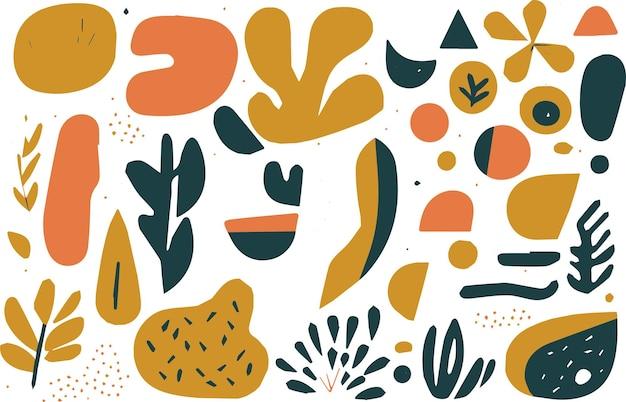Welcome to our blog where we explore the fascinating world of art and design! In today’s post, we’re going to delve into the intriguing realm of organic shapes. Have you ever wondered what makes a shape organic and how it differs from other types of shapes? Well, you’ve come to the right place! We’ll be answering all your burning questions about organic shapes, from their definition and examples to their significance in art and design.
Before we dive in, let’s clarify what we mean by “organic shapes.” Organic shapes, also known as free-form or biomorphic shapes, are irregular and unpredictable in nature. Unlike geometric shapes such as squares, circles, triangles, or rectangles, organic shapes are often inspired by elements in the natural world. They can resemble objects like leaves, clouds, trees, or even the curves of the human body. Organic shapes possess a sense of fluidity, movement, and life, making them intriguing and captivating to the eye.
In this post, we’ll be exploring a variety of examples to help you understand organic shapes better. We’ll also address common questions like whether hands and humans can be considered organic shapes, the reasons behind using organic shapes, and explore the different characteristics that make them unique. So, let’s dive into the world of organic shapes and uncover their beauty together!

What are Some Examples of Organic Shapes?
In the world of design, organic shapes are the wild children, the rebels that refuse to conform to the straight-laced rules of geometry. These shapes are free-spirited, unconstrained, and can be found all around us, bringing a touch of whimsy and natural beauty to our lives. So, what are some examples of organic shapes? Let’s take a whimsical journey through a few delightful examples:
1. Clouds: Nature’s Abstract Art Gallery
Ah, clouds—the fluffy masters of the sky. These ethereal creations come in all sorts of shapes, shifting and morphing as they lazily float across the heavens. From cotton candy puffs to dramatic thunderheads, clouds are the epitome of organic shapes. Just imagine lying on a grassy hill, gazing up at the sky, and letting your imagination run wild as the clouds form into whimsical creatures, mystical landscapes, or maybe just a really big ice cream sundae.
2. Rorschach Tests: Where Art and Psychology Collide
Who knew that inkblots could be so fascinating? Rorschach tests, created by Swiss psychologist Hermann Rorschach, present a series of ambiguous, symmetrical shapes. The interpretations drawn from these inkblots allow psychologists to gain insights into the inner workings of our minds. But let’s not get too deep here! Just enjoy the random, flowing shapes and let your imagination conjure up images of majestic owls, carefree butterflies, or maybe even your Aunt Mabel’s prized meatloaf recipe.
3. Amoebas: The Coolest Single-Cell Citizens
Amoebas might be the ultimate shape-shifting artists. These microscopic organisms, often found in freshwater or soil, have no fixed form. They can extend their pseudopods (temporary protrusions) to move and feed, constantly morphing into new shapes. Talk about being adaptable! Amoebas can be spherical one moment and then stretch out like an amoeba-sized Gumby the next. They are definitely the shape-shifters of the natural world.
4. Stones on a Riverbed: Nature’s Pebble Mosaic
Take a stroll along a peaceful riverbank, and you’ll stumble upon a mosaic of smoothed pebbles. These stones, shaped by the relentless flow of water over time, come in all sorts of organic shapes. From ovals to teardrops, each one is unique and bears the stamp of nature’s artistic touch. So, the next time you find yourself near a river, take a moment to appreciate the marvelous shapes designed by the forces of erosion.
5. Doodles: Scribbles with Personality
In the margins of notebooks and the back of napkins, doodles come to life. These unplanned sketches, drawn absentmindedly or during boring meetings, often display organic shapes bursting with creativity. Whether it’s a squiggly line that turns into a ferocious dragon or a haphazard collection of curves morphing into a cute little penguin, doodles show that even the most mundane moments can give rise to something imaginative and delightful.
So, there you have it, a few examples of organic shapes that add a touch of whimsy and beauty to our lives. From clouds and Rorschach tests to amoebas and riverbed stones, these organic shapes remind us that not everything in life needs to be straight-edged and predictable. Embrace the free-spirited world of organic shapes and let your imagination roam free.

FAQ: What are some examples of organic shapes?
Are Hands organic shapes
Yes, hands are a classic example of organic shapes! Their unique curves and contours make them a prime example of organic shapes in nature and art. Just take a look at your own hand, and you’ll see a wonderful combination of flowing lines and graceful curves. So, whether you’re drawing a hand for artistic purposes or simply admiring its natural beauty, hands definitely fall under the category of organic shapes.
Why do people use organic shapes
People use organic shapes for a variety of reasons. One of the main advantages of organic shapes is their ability to represent the natural world around us. Unlike geometric shapes, organic shapes mimic the forms found in nature and evoke a sense of harmony, fluidity, and beauty. Organic shapes can add a touch of realism, warmth, and emotion to artistic compositions, graphic designs, and even interior spaces. So, if you want to bring an element of the natural world into your creations, organic shapes are the way to go!
What is another name for organic shapes
Another term often used for organic shapes is “freeform shapes.” These shapes are characterized by their irregularity and lack of rigid structure. Freeform shapes are a stark contrast to geometric shapes, which have defined lines and angles. By choosing to use freeform or organic shapes, artists and designers can create compositions that feel more dynamic, flowing, and natural. So, when you come across either “organic shapes” or “freeform shapes,” remember that they refer to the same captivating and curvaceous entities!
What are the 4 basic shapes
The four basic shapes are the circle, square, triangle, and rectangle. These shapes, also known as geometric shapes, form the foundation of many visual designs and compositions. While they provide structure and simplicity, they may lack the intricate complexity and organic feel of other shapes. Nonetheless, these basic shapes have stood the test of time as fundamental building blocks in art, design, and our everyday lives.
What is an organic shape in art
In art, an organic shape refers to a shape that is irregular, curvaceous, and reminiscent of natural forms. Organic shapes can be found in everything from landscapes and animals to the human body. Unlike geometric shapes, which are precise and symmetrical, organic shapes embrace the imperfect beauty found in the world around us. Painters, sculptors, and other artists often use organic shapes to capture the essence and vitality of the subject matter, creating visually captivating and emotionally evocative works of art.
Are humans organic shapes
Absolutely! Humans are the epitome of organic shapes. The human body, with its graceful curves, flowing lines, and intricate details, is a masterpiece of organic shapes. From the curve of our spines to the contour of our muscles, every aspect of the human form exemplifies the beauty and complexity of organic shapes. So, the next time you look in the mirror, take a moment to appreciate the organic artwork that is your very own body!
What are the 9 basic shapes
While the four basic shapes are important, there are also nine basic shapes that encompass both geometric and organic forms. These nine shapes include the circle, square, triangle, rectangle, oval, crescent, star, heart, and diamond. Each shape brings its own unique character and aesthetic appeal to compositions. So, whether you’re designing a logo, creating a piece of art, or decorating a space, these foundational shapes are the perfect starting point for your creative endeavors.
Now that you know more about organic shapes, embrace their fluidity, embrace their beauty, and let them inspire your artistic and design adventures!
